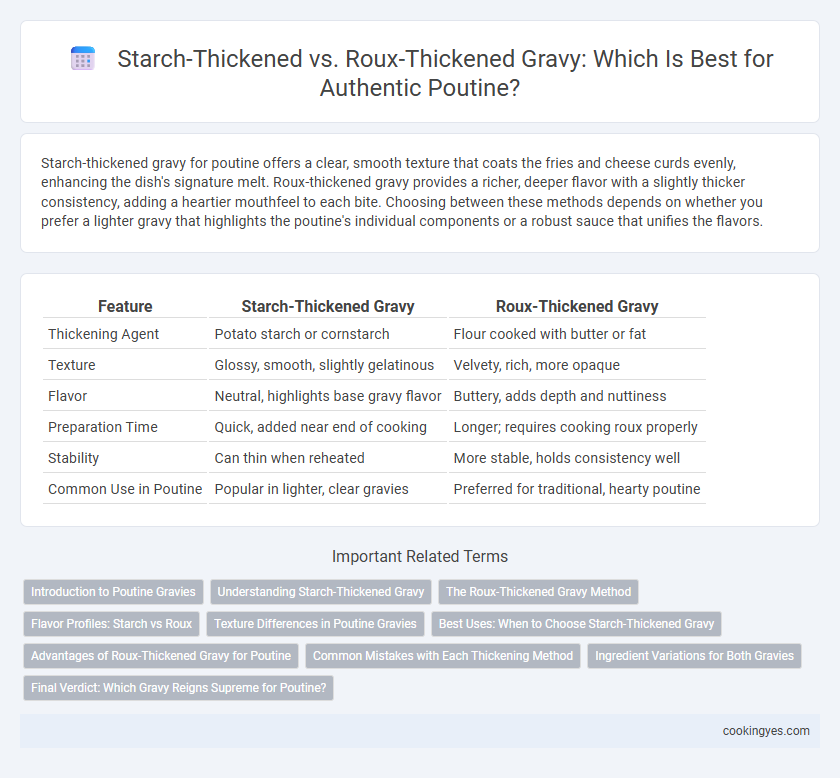Starch-thickened gravy for poutine offers a clear, smooth texture that coats the fries and cheese curds evenly, enhancing the dish's signature melt. Roux-thickened gravy provides a richer, deeper flavor with a slightly thicker consistency, adding a heartier mouthfeel to each bite. Choosing between these methods depends on whether you prefer a lighter gravy that highlights the poutine's individual components or a robust sauce that unifies the flavors.
Table of Comparison
| Feature | Starch-Thickened Gravy | Roux-Thickened Gravy |
|---|---|---|
| Thickening Agent | Potato starch or cornstarch | Flour cooked with butter or fat |
| Texture | Glossy, smooth, slightly gelatinous | Velvety, rich, more opaque |
| Flavor | Neutral, highlights base gravy flavor | Buttery, adds depth and nuttiness |
| Preparation Time | Quick, added near end of cooking | Longer; requires cooking roux properly |
| Stability | Can thin when reheated | More stable, holds consistency well |
| Common Use in Poutine | Popular in lighter, clear gravies | Preferred for traditional, hearty poutine |
Introduction to Poutine Gravies
Starch-thickened gravies for poutine rely on cornstarch or potato starch to achieve a translucent, glossy texture that clings well to cheese curds and fries. Roux-thickened gravies use a cooked mixture of flour and fat, providing a richer, deeper flavor and a thicker, creamier consistency. Both methods are essential in crafting authentic poutine gravies, influencing the dish's texture and flavor profile.
Understanding Starch-Thickened Gravy
Starch-thickened gravy for poutine relies on cornstarch or potato starch to achieve a clear, glossy texture that coats fries and cheese curds without becoming overly heavy. This method offers a lighter consistency and quicker preparation compared to roux-thickened gravies, making it ideal for fast-service poutine restaurants. Precise temperature control is crucial to prevent starch breakdown and maintain the gravy's smooth, velvety finish characteristic of authentic Quebec-style poutine.
The Roux-Thickened Gravy Method
Roux-thickened gravy for poutine offers a rich, velvety texture achieved by cooking equal parts flour and fat before gradually incorporating broth, creating a smooth base that clings perfectly to fries and cheese curds. This method enhances flavor complexity through the caramelization of the roux, resulting in a deep, savory profile that starch-thickened gravies often lack. The controlled cooking process allows for a consistent thickness, ensuring optimal coating without a gummy or overly gelatinous mouthfeel, making it a preferred choice for authentic Quebec-style poutine.
Flavor Profiles: Starch vs Roux
Starch-thickened gravy for poutine offers a clean, neutral base that highlights the natural flavors of the meat broth, delivering a smooth and glossy texture without overpowering the dish. Roux-thickened gravy introduces a richer, nuttier flavor due to the browned flour, adding depth and complexity that complements the savory cheese curds and fries. The choice between starch and roux impacts the overall taste experience by balancing subtle clarity with robust, toasted nuances in the gravy.
Texture Differences in Poutine Gravies
Starch-thickened gravy in poutine provides a smooth, glossy texture that clings evenly to fries and cheese curds, enhancing the dish's signature bite without overwhelming it. Roux-thickened gravy results in a richer, more complex mouthfeel with a slightly denser consistency, offering a velvety coating that intensifies the overall flavor profile. The choice between starch and roux significantly influences the gravy's viscosity and how it interacts with the key components of poutine, affecting both taste and texture balance.
Best Uses: When to Choose Starch-Thickened Gravy
Starch-thickened gravy is ideal for poutine when a glossy, smooth texture is desired that clings well to fries and cheese curds without overpowering their flavors. This type of gravy maintains a lighter consistency, ensuring the dish remains moist but not overly heavy, perfect for traditional Quebec-style poutine. It works best with quick-cook preparations and offers a clean, neutral base that complements the savory notes of the meat or vegetable stock used.
Advantages of Roux-Thickened Gravy for Poutine
Roux-thickened gravy offers a rich, velvety texture that clings perfectly to fries and cheese curds, enhancing the overall mouthfeel of poutine. Its deep, caramelized flavor profile adds complexity and depth, elevating the dish beyond simple starch-thickened sauces. The controlled cooking process of a roux also ensures a consistent thickness and prevents the gravy from becoming too gelatinous or slimy, maintaining the classic poutine experience.
Common Mistakes with Each Thickening Method
Common mistakes with starch-thickened gravy for poutine include overcooking the starch, which causes a gummy texture, and improper tempering that leads to lumps. Roux-thickened gravy often suffers from undercooking the flour, resulting in a raw taste, or using too much fat, making the sauce greasy. Both methods require precise temperature control and timing to achieve a smooth, rich consistency essential to classic poutine gravy.
Ingredient Variations for Both Gravies
Starch-thickened gravy for poutine typically uses cornstarch or potato starch as the primary thickening agent, creating a translucent and glossy texture, while roux-thickened gravy relies on a cooked mixture of flour and fat, often butter, to develop a richer, more opaque consistency. Ingredient variations in starch-thickened gravies may include using broth or stock infused with garlic, onion, or mushrooms for enhanced flavor, whereas roux-based gravies often incorporate caramelized onions, herbs, and sometimes a splash of red wine or Worcestershire sauce to deepen complexity. Both methods allow for customization, but starch-thickened gravies tend to emphasize clarity and lightness, contrasted by the hearty, velvety mouthfeel achieved by roux-thickened gravies.
Final Verdict: Which Gravy Reigns Supreme for Poutine?
Starch-thickened gravy for poutine delivers a glossy, smooth texture that clings well to fries and cheese curds, enhancing the iconic bite. Roux-thickened gravy offers a richer, more complex flavor profile with a velvety consistency, elevating the dish's savory depth. For authentic poutine, roux-thickened gravy reigns supreme due to its balance of thickness and flavor intensity that perfectly complements the toppings.
Starch-thickened vs roux-thickened gravy for poutine Infographic

 cookingyes.com
cookingyes.com